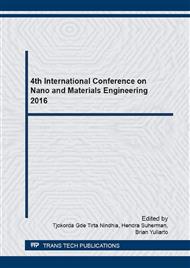[1]
Kamat P V. Quantum Dot Solar Cells. The Next Big Thing in Photovoltaics. J Phys Chem Lett; 4 (2013) 908–918.
DOI: 10.1021/jz400052e
Google Scholar
[2]
Kojima A, Teshima K, Shirai Y, et al. Novel Photoelectrochemical Cell with Mesoscopic Electrodes Sensitized by Lead-halide Compounds (11). Meet Abstr; MA2008-02: 27.
DOI: 10.1149/ma2008-02/1/27
Google Scholar
[3]
Burschka J, Dualeh A, Kessler F, et al. Tris(2-(1H-pyrazol-1-yl)pyridine)cobalt(III) as p-type dopant for organic semiconductors and its application in highly efficient solid-state dye-sensitized solar cells. J Am Chem Soc; 133 (2011) 18042–18045.
DOI: 10.1021/ja207367t
Google Scholar
[4]
Bi D, Moon S-J, Häggman L, et al. Using a two-step deposition technique to prepare perovskite (CH3NH3PbI3) for thin film solar cells based on ZrO2 and TiO2 mesostructures. RSC Adv; 3 (2013) 18762.
DOI: 10.1039/c3ra43228a
Google Scholar
[5]
Bi D, Yang L, Boschloo G, et al. Effect of Different Hole Transport Materials on Recombination in CH 3 NH 3 PbI 3 Perovskite-Sensitized Mesoscopic Solar Cells. J Phys Chem Lett; 4 (2013)1532–1536.
DOI: 10.1021/jz400638x
Google Scholar
[6]
Huang J, Yin Z, Zheng Q. Applications of ZnO in organic and hybrid solar cells. Energy Environ Sci; 4 (2011) 3861.
Google Scholar
[7]
Liu D, Kelly TL. Perovskite solar cells with a planar heterojunction structure prepared using room-temperature solution processing techniques. Nat Photonics; 8 (2014) 133–138.
DOI: 10.1038/nphoton.2013.342
Google Scholar
[8]
Liang L, Huang Z, Cai L, et al. Magnetron sputtered zinc oxide nanorods as thickness-insensitive cathode interlayer for perovskite planar-heterojunction solar cells. ACS Appl Mater Interfaces; 6 (2014) 20585–20589.
DOI: 10.1021/am506672j
Google Scholar
[9]
Laban WA, Etgar L. Depleted hole conductor-free lead halide iodide heterojunction solar cells. Energy Environ Sci; 6 (2013) 3249.
DOI: 10.1039/c3ee42282h
Google Scholar
[10]
Etgar L, Gao P, Xue Z, et al. Mesoscopic CH3NH3PbI3/TiO2 heterojunction solar cells. J Am Chem Soc; 134 (2012)17396–7399.
Google Scholar
[11]
Zhou H, Chen Q, Li G, et al. Interface engineering of highly efficient perovskite solar cells. Science (80- ); 345 (2014) 542–546.
Google Scholar
[12]
Ko H-S, Lee J-W, Park N-G. 15. 76% Efficiency Perovskite Solar Cell Prepared under High Relative Humidity: Importance of PbI2 Morphology in Two-Step Deposition of CH3NH3PbI3. J Mater Chem A; 3 (2015) 8808–8815.
DOI: 10.1039/c5ta00658a
Google Scholar
[13]
Sfyri G, Kumar CV, Raptis D, et al. Study of perovskite solar cells synthesized under ambient conditions and of the performance of small cell modules. Sol Energy Mater Sol Cells; 134 (2015) 60–63.
DOI: 10.1016/j.solmat.2014.11.034
Google Scholar
[14]
Jeng J-Y, Chiang Y-F, Lee M-H, et al. CH3NH3PbI3 perovskite/fullerene planar-heterojunction hybrid solar cells. Adv Mater; 25 (2013) 3727–3732.
DOI: 10.1002/adma.201301327
Google Scholar
[15]
Kim H-B, Choi H, Jeong J, et al. Mixed solvents for the optimization of morphology in solution-processed, inverted-type perovskite/fullerene hybrid solar cells. Nanoscale; 6 (2014) 6679–6683.
DOI: 10.1039/c4nr00130c
Google Scholar
[16]
Burschka J, Pellet N, Moon S-J, et al. Sequential deposition as a route to high-performance perovskite-sensitized solar cells. Nature; 499 (2013) 316–319.
DOI: 10.1038/nature12340
Google Scholar
[17]
Malinkiewicz O, Yella A, Lee YH, et al. Perovskite solar cells employing organic charge-transport layers. Nat Photonics; 8 (2014) 128–132.
DOI: 10.1038/nphoton.2013.341
Google Scholar


